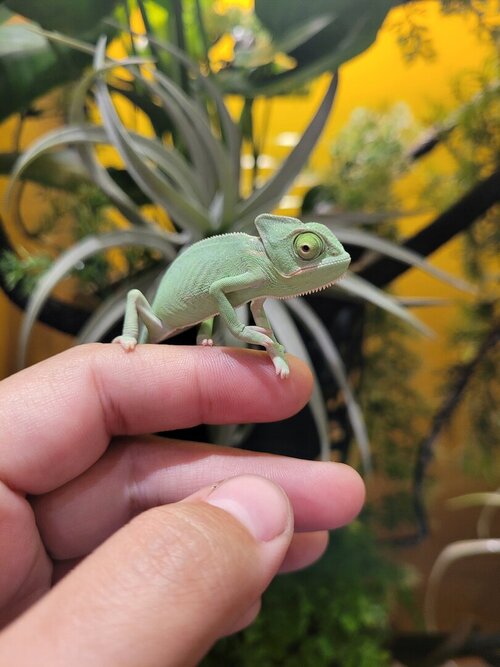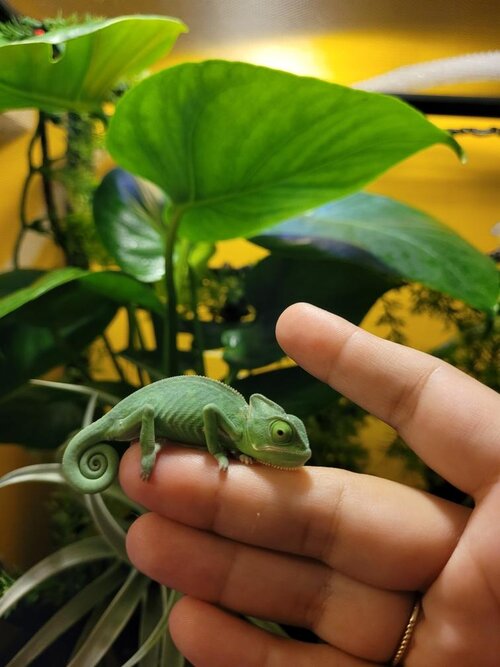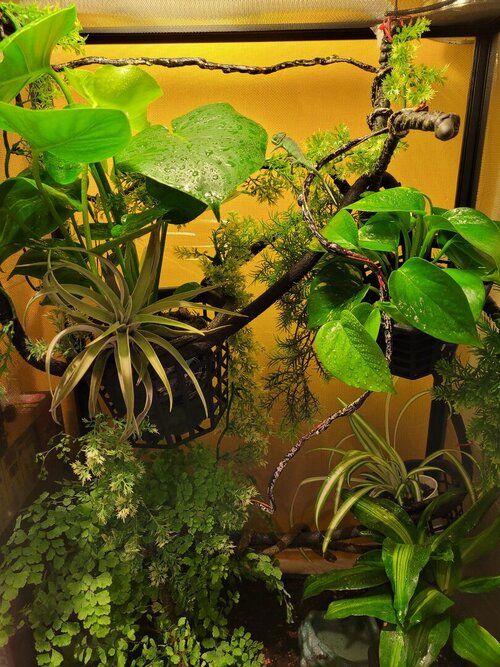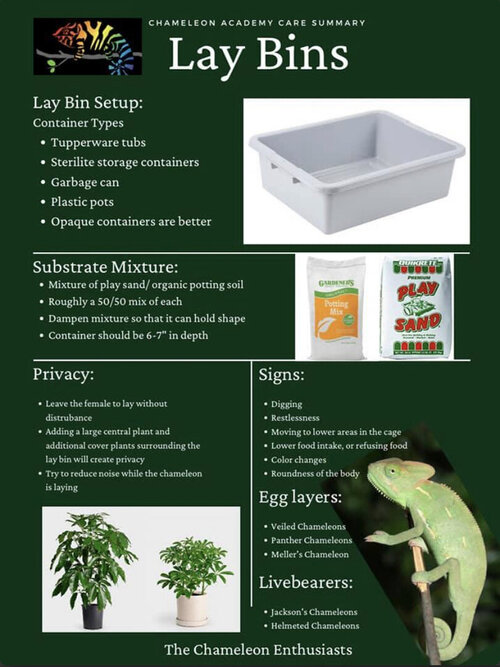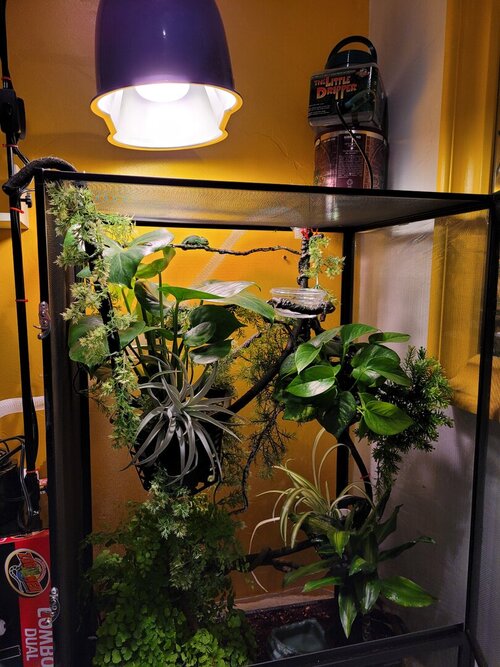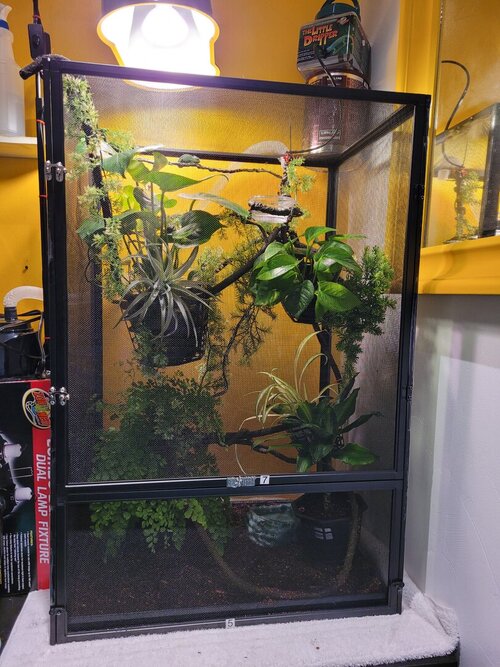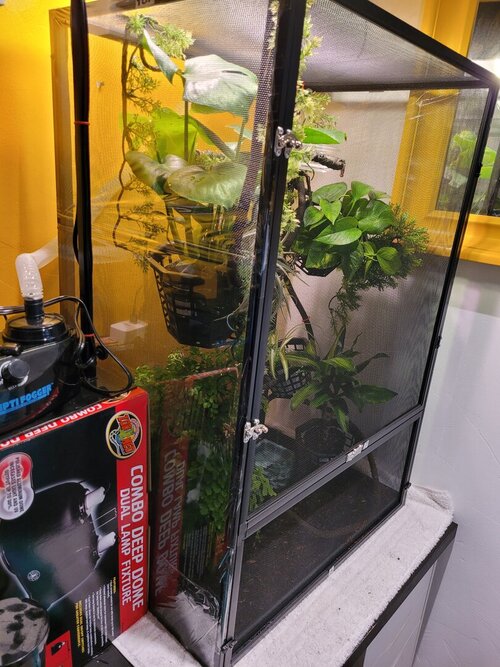aleagueofherown
Established Member
Hi! My name is Liv, and my chameleon's name is Ivy. My partner and I have a 7 year old daughter who lives with us half the time and is O-B-S-E-S-S-E-D with reading about reptiles. I am a physician licensing coordinator (and disabled Army veteran) and my partner is a school teacher for 6th - 8th grade. Due to the pandemic, he works from home every day and I work from home 3x/week. We have 4 well-trained dogs (they spend most of their days basking in the sunshine on their cots outside but during inside time, we are always present to assure nothing happens to compromise animal safety). I'm sure I already sound like a piece of work, but I promise I am eager to learn! I am just so appreciative that a community like this exists. I am amazed by the incredible husbandry that people here have devoted themselves to and have already learned so much in the last 2 weeks before I finally got up the courage today to create an account and post! TL;DR I'm a mom to a tiny human and 4 pups, we are obsessed with our new chameleon, I am grateful for this community already and I am always ready to learn more.
Chameleon Info:
Cage Info:
Current Problem - I just want to make sure that we are doing everything properly. I previously owned leopard geckos, a bearded dragon, some turtles, frogs, a ball python. I have never owned a chameleon. I have so many questions! I realize that many of these questions are discussed on the forums, but I often see differing opinions and want to be as up to date as possible on my information. Thank you in advance for even bothering to read this far!
Should I invest in a misting system?
Is there a drainage system we should use aside from the provided tray and substrate? The substrate is Zilla - Fir & Sphagnum Peat Moss.
Does anyone travel with a chameleon? We frequently visit cabins (I am training for a half marathon right now and this helps with altitude adjustment) and are wondering if we should have someone check on her?
Does she need a hideout? I've seen some people use halved coconuts or moss domes for their chams.
Are there non-artificial vines that I can purchase? I feel really silly asking this.
Which is the best digital hygrometer system (are there any that can connect via Bluetooth to your phone (is it wildly obsessed of me to even ask that)? I have heard good things about this one.
Should I get a temperature gun?
What other plants would be good to get for her enclosure, and where in the habitat is the best placement?
What is best to insulate the enclosure with from the cold walls at night?
Is moss a good idea (I have seen posts here and all over the internet that indicate otherwise) or not?
Are the general/lighting timers a good idea? If so, what's a good schedule for a veiled?
Should I be feeding her anything else yet besides the tiny crickets?
Do I always need to use distilled water? I have seen photos/videos of people letting their chams drink from a faucet or shower.
Should I purchase a larger lamp for overall enclosure light/does she need the nighttime lamp we currently use?
What type of branches should I purchase and from where? Can I use branches that I find on a hike if I know the tree/bush type?
For now, her enclosure is just the right size for our space. Is there anything else I can do to ensure she is the most comfortable?
Chameleon Info:
- Your Chameleon - Veiled, F, about 5-6 weeks old? She has been home with us about 32 hours and was purchased from LLL Reptile in San Diego.
- Handling - Since coming home, she was only handled for a few minutes today so that I could place live plants in her enclosure and show her where the food bowl is located
- Feeding - 3 small crickets in a glass bowl dusted with calcium, offered in the morning (about 8AM) after about 20 minutes awake and refreshed around 12PM, offered again around 3PM if she finished the previous feed. Gut-loading with Repashy Superfoods Bug Burger (and this morning, some strawberry). She has eaten about 6 crickets since coming home with us yesterday.
- Supplements - Sticky Tongue Farms Miner-All (w/out D3), Rep-Cal w/D3 <--have not yet given her this as we were advised to only dust with it 2x/month
- Watering - We have a Little Dripper setup with distilled water to drip onto the branches/plants close to her feeding branch. We have seen her drink multiple times from the plant leaves with no issue.
- Fecal Description - Color and consistency are unremarkable. Brown, soft but not lacking firm structure. Urates are white, with some clear fluid surrounding. I think she has pooped twice (both in the same spot) since we brought her home yesterday afternoon.
- History - She's a baby, and we honestly don't know much beyond that.
Cage Info:
- Cage Type - Exo Terra (Medium, X-Tall) 24"x18"x36" Black Aluminum Screen Habitat covered on 3 sides and lower tray door with saran wrap (with small slits on each panel), left side covered with towel (the side my partner sits on when using his computer), front hinge door covered with towel after 12PM until 8AM. We plan to replace the saran wrap with clear shower curtain in the very near future.
- Lighting - The lamp we are using is on a stand, but it will soon be mounted on an extended hook from the wall; we are pretty handy in our small space. We currently have a Zoo Med Combo Deep Dome Dual Lamp Fixture with an Exo Terra UVB 100 Reptile Bulb during the day (0800-2000) paired with an Exo Terra 150W Daylight Basking Spot bulb placed 13" above her basking branch. We were advised to switch out the day time bulb at 2000 with an Exo Terra 75W Night Heat Lamp bulb (still 13" above her basking branch).
- Temperature - Cage floor 70°F, mid-cage 75°F, basking spot - 87°F. Measured with some (probably) wonky hygrometers from Petsmart. Our room is a super tiny studio on my parents' property (10'x12') but the original buildings on the property were built in the early 1900's and do not have (any) adequate insulation. We use an indoor space heater to keep the ambient temperature above 60 at night. Translation: it gets cold AF (some odd 40°F* in here) at night and on stormy days (those don't happen often here though) between November - March; it is typically warmer April - October and the ambient temperature inside is decent. *Pathetic I know.
- Humidity - Humidity averages about 45-50% during the day and about 55-60% at night. We are still working on figuring out the best way to maintain. At this time we are currently hand-misting twice a day with a spray bottle of water around 8AM and 2PM, and fogging with the Zoo Med Repti Fogger.
- Plants - We are working on replacing the artificial vines and small hanging plants with live plants and branches in the very near future. For live plants we currently have a Monstera deliciosa (Swiss cheese plant), Dracaena deramensis (Hawaiian sunshine), Epipremnum aureum (Devil's ivy), Chlorophytum comosum (Spider plant), Adiantum raddianum (Delta maiden hair fern), and Tillandsia harrisii (bromeliad/air plant)
- Placement - The enclosure is on my partner's desk, behind mine. It is in a corner and there is wall along the back and to the right. There is about a foot between the enclosure and his computer, but that side is covered with a towel (over the saran wrap). It is not installed near any fans, air vents, windows, or high traffic areas. The top of the cage is about 65" from the floor.
- Location - We live in San Diego, California.
Current Problem - I just want to make sure that we are doing everything properly. I previously owned leopard geckos, a bearded dragon, some turtles, frogs, a ball python. I have never owned a chameleon. I have so many questions! I realize that many of these questions are discussed on the forums, but I often see differing opinions and want to be as up to date as possible on my information. Thank you in advance for even bothering to read this far!
Should I invest in a misting system?
Is there a drainage system we should use aside from the provided tray and substrate? The substrate is Zilla - Fir & Sphagnum Peat Moss.
Does anyone travel with a chameleon? We frequently visit cabins (I am training for a half marathon right now and this helps with altitude adjustment) and are wondering if we should have someone check on her?
Does she need a hideout? I've seen some people use halved coconuts or moss domes for their chams.
Are there non-artificial vines that I can purchase? I feel really silly asking this.
Which is the best digital hygrometer system (are there any that can connect via Bluetooth to your phone (is it wildly obsessed of me to even ask that)? I have heard good things about this one.
Should I get a temperature gun?
What other plants would be good to get for her enclosure, and where in the habitat is the best placement?
What is best to insulate the enclosure with from the cold walls at night?
Is moss a good idea (I have seen posts here and all over the internet that indicate otherwise) or not?
Are the general/lighting timers a good idea? If so, what's a good schedule for a veiled?
Should I be feeding her anything else yet besides the tiny crickets?
Do I always need to use distilled water? I have seen photos/videos of people letting their chams drink from a faucet or shower.
Should I purchase a larger lamp for overall enclosure light/does she need the nighttime lamp we currently use?
What type of branches should I purchase and from where? Can I use branches that I find on a hike if I know the tree/bush type?
For now, her enclosure is just the right size for our space. Is there anything else I can do to ensure she is the most comfortable?

